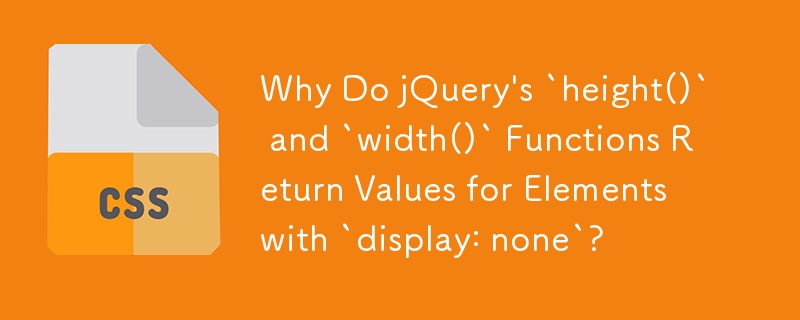 Web Front-end
Web Front-end
 CSS Tutorial
CSS Tutorial
 Why Do jQuery\'s `height()` and `width()` Functions Return Values for Elements with `display: none`?
Why Do jQuery\'s `height()` and `width()` Functions Return Values for Elements with `display: none`?
Why Do jQuery\'s `height()` and `width()` Functions Return Values for Elements with `display: none`?

jQuery: height()/width() vs. "display:none"
You may have assumed that elements with a CSS style of "display:none" would return 0 for height() and width() in jQuery. However, as demonstrated in the example provided, this is not always the case.
Why does this happen? To understand this behavior, we need to delve into how jQuery handles hidden elements.
If an element has an offsetWidth of 0 (which jQuery interprets as "hidden"), it attempts to determine its height. It does this by temporarily altering the element's styling:
- position: "absolute"
- visibility: "hidden"
- display: "block"
Once the height is obtained via getWidthOrHeight(...) and adjusted for borders and padding if necessary, the previous styling is restored.
In essence, jQuery takes the hidden element, temporarily displays it outside of the document flow, retrieves its height, and then hides it again, all without affecting the visual appearance of the page. This allows height() and width() to provide accurate measurements even for hidden elements, provided their parents are visible.
This mechanism is built into jQuery's height() and width() methods, eliminating the need for you to manually manipulate the element's visibility.
The above is the detailed content of Why Do jQuery\'s `height()` and `width()` Functions Return Values for Elements with `display: none`?. For more information, please follow other related articles on the PHP Chinese website!

Hot AI Tools

Undresser.AI Undress
AI-powered app for creating realistic nude photos

AI Clothes Remover
Online AI tool for removing clothes from photos.

Undress AI Tool
Undress images for free

Clothoff.io
AI clothes remover

Video Face Swap
Swap faces in any video effortlessly with our completely free AI face swap tool!

Hot Article

Hot Tools

Notepad++7.3.1
Easy-to-use and free code editor

SublimeText3 Chinese version
Chinese version, very easy to use

Zend Studio 13.0.1
Powerful PHP integrated development environment

Dreamweaver CS6
Visual web development tools

SublimeText3 Mac version
God-level code editing software (SublimeText3)

Hot Topics
 1659
1659
 14
14
 1415
1415
 52
52
 1310
1310
 25
25
 1258
1258
 29
29
 1232
1232
 24
24
 Google Fonts Variable Fonts
Apr 09, 2025 am 10:42 AM
Google Fonts Variable Fonts
Apr 09, 2025 am 10:42 AM
I see Google Fonts rolled out a new design (Tweet). Compared to the last big redesign, this feels much more iterative. I can barely tell the difference
 How to Create an Animated Countdown Timer With HTML, CSS and JavaScript
Apr 11, 2025 am 11:29 AM
How to Create an Animated Countdown Timer With HTML, CSS and JavaScript
Apr 11, 2025 am 11:29 AM
Have you ever needed a countdown timer on a project? For something like that, it might be natural to reach for a plugin, but it’s actually a lot more
 HTML Data Attributes Guide
Apr 11, 2025 am 11:50 AM
HTML Data Attributes Guide
Apr 11, 2025 am 11:50 AM
Everything you ever wanted to know about data attributes in HTML, CSS, and JavaScript.
 A Proof of Concept for Making Sass Faster
Apr 16, 2025 am 10:38 AM
A Proof of Concept for Making Sass Faster
Apr 16, 2025 am 10:38 AM
At the start of a new project, Sass compilation happens in the blink of an eye. This feels great, especially when it’s paired with Browsersync, which reloads
 How We Created a Static Site That Generates Tartan Patterns in SVG
Apr 09, 2025 am 11:29 AM
How We Created a Static Site That Generates Tartan Patterns in SVG
Apr 09, 2025 am 11:29 AM
Tartan is a patterned cloth that’s typically associated with Scotland, particularly their fashionable kilts. On tartanify.com, we gathered over 5,000 tartan
 How to Build Vue Components in a WordPress Theme
Apr 11, 2025 am 11:03 AM
How to Build Vue Components in a WordPress Theme
Apr 11, 2025 am 11:03 AM
The inline-template directive allows us to build rich Vue components as a progressive enhancement over existing WordPress markup.
 PHP is A-OK for Templating
Apr 11, 2025 am 11:04 AM
PHP is A-OK for Templating
Apr 11, 2025 am 11:04 AM
PHP templating often gets a bad rap for facilitating subpar code — but that doesn't have to be the case. Let’s look at how PHP projects can enforce a basic
 Programming Sass to Create Accessible Color Combinations
Apr 09, 2025 am 11:30 AM
Programming Sass to Create Accessible Color Combinations
Apr 09, 2025 am 11:30 AM
We are always looking to make the web more accessible. Color contrast is just math, so Sass can help cover edge cases that designers might have missed.



